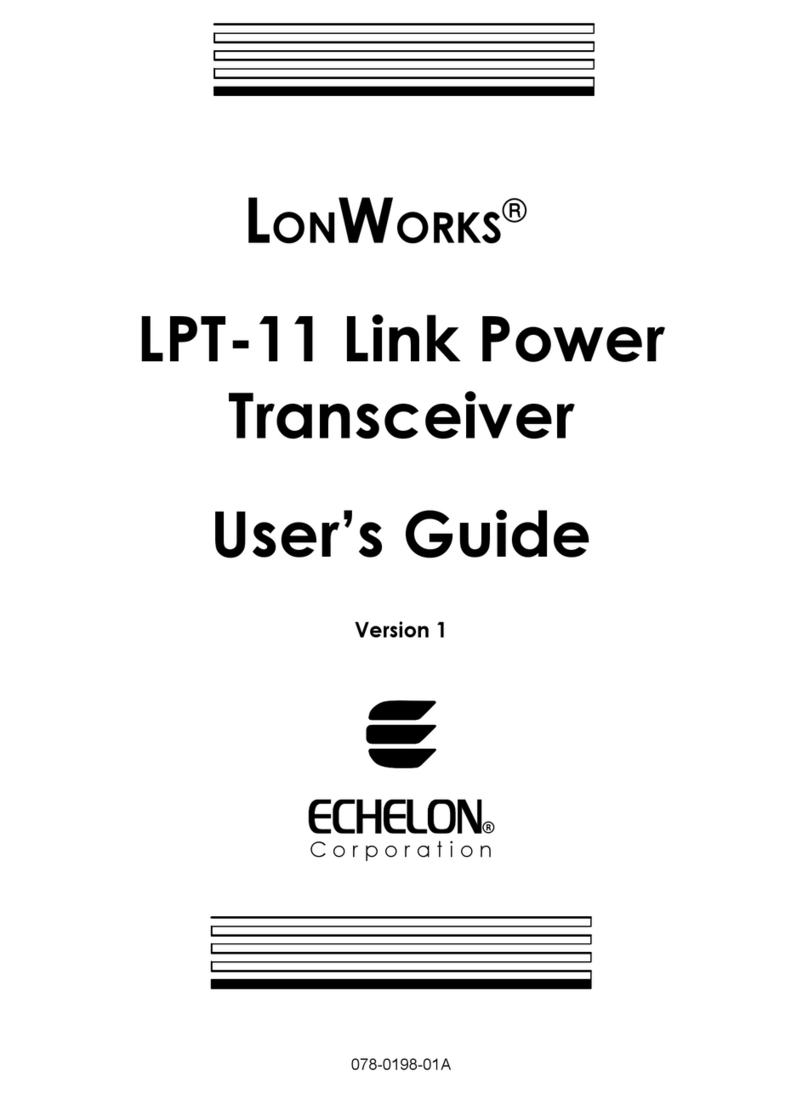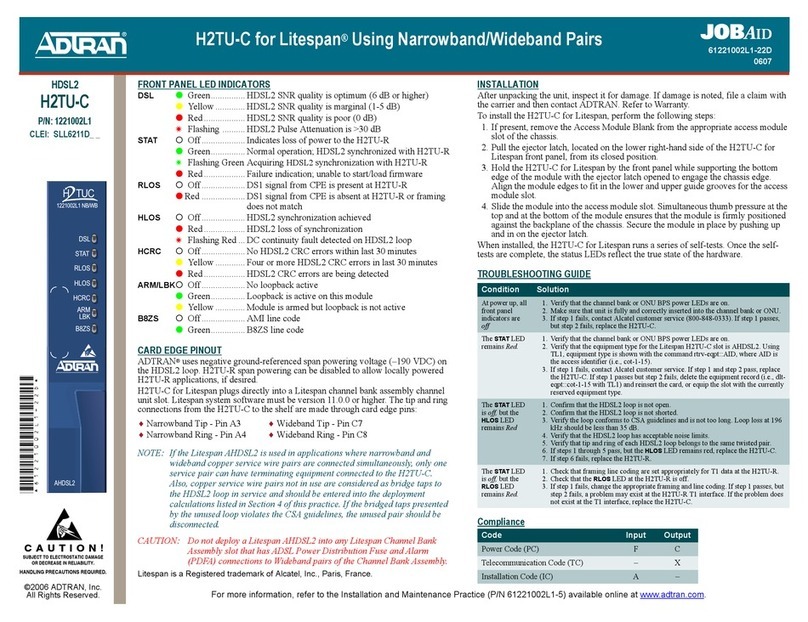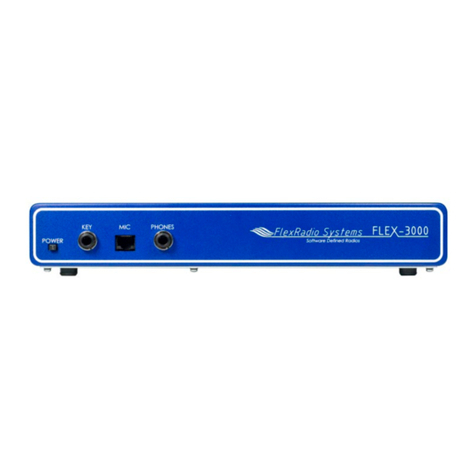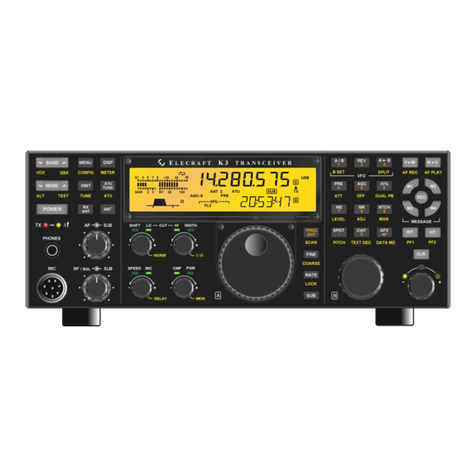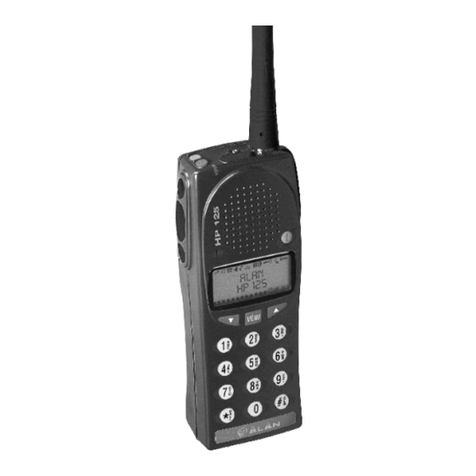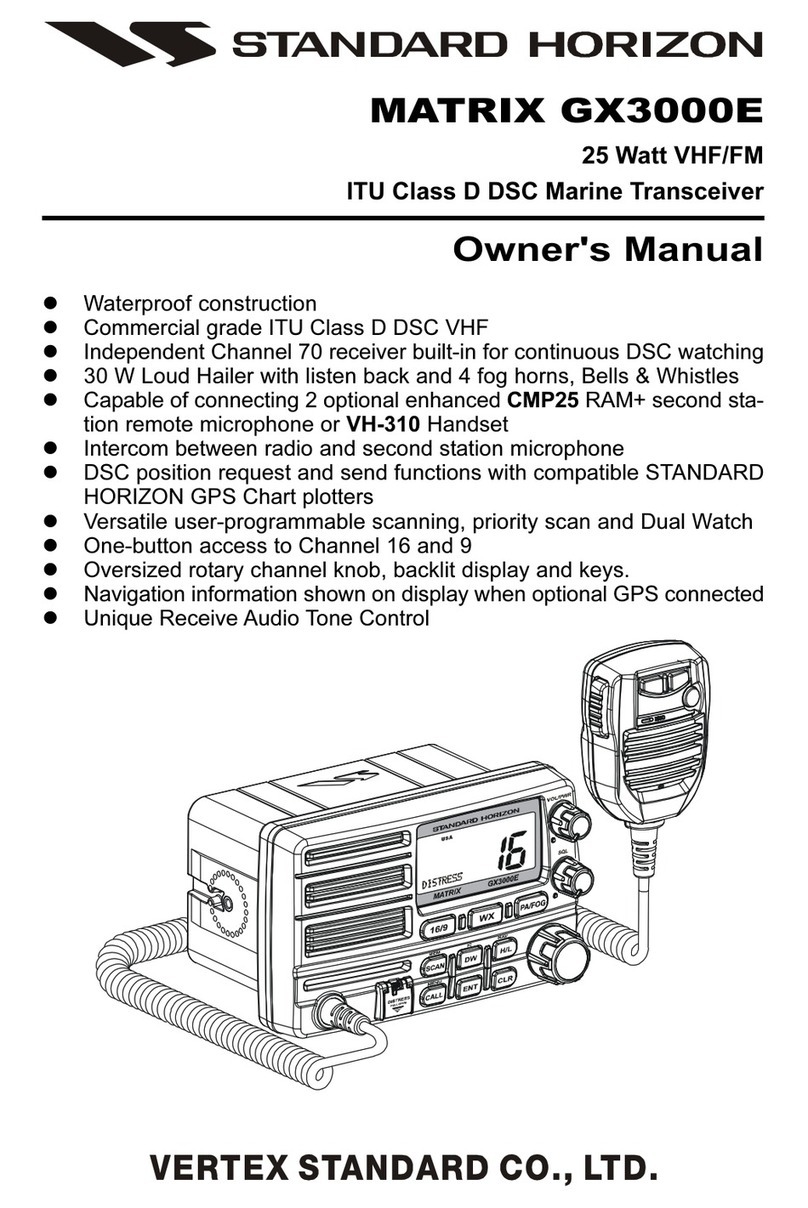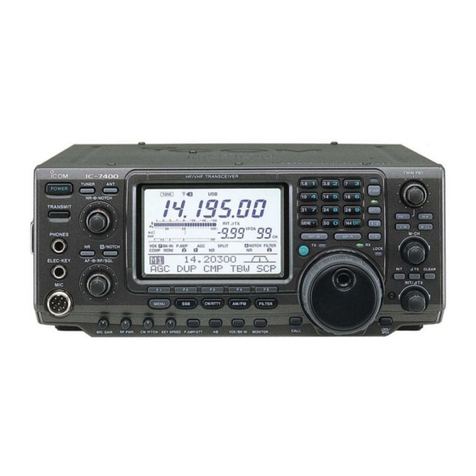Echelon LONWORKS PLT-22 User manual

LONWORKS®
PLT-22 Power Line Transceiver
User’s Guide
(110kHz – 140kHz Operation)
Version 1.2
@ ECHELON®
C o r p o r a t i o n
078-0175-01C

Echelon, LON, LONWORKS, LonBuilder, NodeBuilder, LonManager, LonTalk,
LONMARK, Neuron, 3120, 3150, the LonUsers logo, the LONMARK logo, and
the Echelon logo are trademarks of Echelon registered in the United States
and other countries. LonPoint, LonSupport, and LonMaker are trademarks
of Echelon Corporation.
Other brand and product names are trademarks or registered
trademarks of their respective holders.
Neuron Chips, Power Line products, and other OEM Products were not
designed for use in equipment or systems which involve danger to
human health or safety or a risk of property damage, and Echelon
assumes no responsibility or liability for use of the Neuron Chips or Power
Line products in such applications.
Parts manufactured by vendors other than Echelon and referenced in
this document have been described for illustrative purposes only and
may not have been tested by Echelon. It is the responsibility of the
customer to determine the suitability of these parts for each
application.
ECHELON MAKES AND YOU RECEIVE NO WARRANTIES OR CONDITIONS,
EXPRESS, IMPLIED, STATUTORY OR IN ANY COMMUNICATION WITH YOU,
AND ECHELON SPECIFICALLY DISCLAIMS ANY IMPLIED WARRANTY OF
MERCHANTABILITY OR FITNESS FOR A PARTICULAR PURPOSE.
No part of this publication may be reproduced, stored in a retrieval
system, or transmitted, in any form or by any means, electronic,
mechanical, photocopying, recording, or otherwise, without the prior
written permission of Echelon Corporation.
Printed in the United States of America.
Copyright ©1996 - 2002 by Echelon Corporation.
Echelon Corporation
www.echelon.com

Contents
1 Introduction 1-1
Audience 1-6
Content 1-6
Related Documentation 1-6
2 Using the PLT-22 Transceiver 2-1
Mechanical Dimensions 2-2
PLT-22 Transceiver Pinout 2-3
PLT-22 Transceiver Electrical Specifications 2-4
External Components 2-6
Crystal 2-6
Power Supply Bypassing and Grounding 2-7
Band-in-Use (BIU) and Packet Detect (PKD) LED Connections 2-7
Neuron®Chip Connections 2-8
Transmit Output Level 2-10
TXON Output Signal 2-10
Application Schematic: Neuron 3150®Chip 2-11
Application Schematic: Neuron 3120®Chip 2-12
3 PLT-22 Transceiver Programming 3-1
Dual Carrier Frequency Mode 3-2
CENELEC Access Protocol 3-3
Power Management 3-3
Standard Transceiver Types 3-4
LonBuilder® and NodeBuilder®PLT-22 Transceiver 3-6
Channel Definitions
4 Coupling Circuits 4-1
Power Line Communications 4-2
Coupling Techniques 4-4
Power Line Coupling Basics 4-4
Power Line Coupling Details 4-8
Safety Issues 4-11
Safety Isolation Considerations 4-11
Ground Leakage Currents 4-13
Capacitor Charge Storage 4-13
Line Surge Protection 4-13
Fuse Selection 4-16
Recommended Coupling Circuit Schematics 4-16
Example 1: Line-to-Neutral, Non-Isolated Coupling 4-18
Example 2: Line-to-Neutral, Transformer-Isolated Coupling 4-20
Example 3: Line-to-Earth, Non-Isolated Coupling 4-22
Example 4: Line-to-Earth, Transformer-Isolated Coupling 4-24
LONWORKS PLT-22 Transceiver User’s Guide i

5 Power Supplies for the PLT-22 Transceiver 5-1
Introduction 5-2
Power Supply Design Considerations 5-2
Power Supply-Induced Attenuation 5-2
Power Supply Noise 5-3
Energy Storage Power Supplies 5-3
Energy Storage Capacitor-Input Power Supplies 5-5
Capacitor-Input Power Supply Schematic 5-7
Energy Storage Linear Supplies 5-8
Traditional Linear Power Supplies 5-9
Switching Power Supplies 5-9
Power Supply-Induced Attenuation 5-9
Noise at the Power Supply Input 5-12
Switching Power Supply Frequency Selection 5-12
Switching Power Supply Input Noise Masks 5-12
Switching Power Supply Output Noise Masks 5-17
Options 5-21
Pre-designed Switching Supplies 5-21
Off-the-Shelf Switching Supplies 5-22
Custom Switching Supplies 5-22
6 Design and Test for Electromagnetic Compatibility 6-1
EMI Design Issues 6-2
Designing Systems for EMC (Electromagnetic Compatibility) 6-2
ESD Design Issues 6-4
Designing Systems for ESD Immunity 6-4
Conducted Emissions Testing 6-6
7 Communication Performance Verification 7-1
Why Verify Communication Performance? 7-2
Verification Strategy 7-2
Power Line Test Isolator 7-3
Test Equipment 7-4
Good Citizen Verification 7-6
Unintentional Output Noise Verification 7-6
Excessive Loading Verification 7-7
Transmit Performance Verification 7-10
Receive Performance Verification 7-11
Packet Error Measurement with Nodeutil 7-11
Verification Procedure 7-12
8 References 8-1
Reference Documentation 8-2
Appendix A PLT-22 Transceiver Isolation Transformer A-1
Specifications
PLT-22 Transceiver Isolation Transformer Schematic A-2
PLT-22 Transceiver Isolation Transformer Electrical A-2
Specifications
PLT-22 Transceiver Isolation Transformer Vendors A-3
ii Echelon

Appendix B PLT-22 Transceiver-Based Node Checklist B-1
PLT-22 Transceiver-Based Node Checklist B-2
PLT-22 Transceiver and Neuron Chip Connections B-2
PLT-22 Transceiver Programming B-4
PLT-22 Transceiver Coupling Circuit General B-4
PLT-22 Transceiver Coupling Circuit Components Key B-5
Specifications
PLT-22 Transceiver Power Supply - General B-6
PLT-22 Transceiver Power Supply - Switching Type B-6
EMI & ESD Design B-7
Product Qualification - EMC B-8
Product Qualification - Electromagnetic Immunity and B-8
Communication Performance
Appendix C External Power Supplies with Integrated
Coupling Circuits C-1
Vendors for External Power Supplies w/ Integrated Coupling Circuits C-2
LONWORKS PLT-22 Transceiver User’s Guide iii

iv Echelon

1
Introduction
The PLT-22 Power Line Transceiver provides a simple, cost-effective
method of adding LONWORKS®power line technology to any control
system. Network data are broadcast through the power mains,
eliminating the need for dedicated wiring and greatly reducing
installation costs. A replacement for Echelon's popular PLT-21 Power
Line Transceiver, the PLT-22 transceiver also includes several new
features to significantly improve communications reliability and lower
node cost.
LONWORKS PLT-22 Transceiver User’s Guide 1-1

Intermittent noise sources, impedance changes, and attenuation make the power line
a hostile signal path. The PLT-22 transceiver operates reliably in this harsh
environment through a novel dual carrier frequency capability as well as custom
digital signal processing which provides adaptive carrier and data correlation,
impulse noise cancellation, tone rejection, and low-overhead error correction. These
innovations permit the transceiver to operate reliably in the presence of consumer
electronics, power line intercoms, motor noise, electronic ballasts, dimmers, and
other typical sources of interference.
Each PLT-22 transceiver operates as a backward compatible replacement for the
PLT-20 and PLT-21 transceivers when used with previous versions of configuration
parameters. In this mode, all transmissions can be received by any PLT-20, PLT-21,
or PLT-22 transceiver.
When used with new transceiver configuration parameters, the dual carrier
frequency mode of the PLT-22 transceiver is activated. In this mode, PLT-22 based-
nodes are able to communicate even when the primary frequency range (125kHz -
140kHz) is blocked by noise. With dual frequency mode, a PLT-22 transceiver begins
each transaction by sending backward compatible packets. If impairments prevent
communication in this frequency range, the PLT-22 node will automatically switch
carrier frequencies in order to complete the transaction with other PLT-22 based
nodes.
The PLT-22 transceiver complies with FCC, Industry Canada, Japan MPT, and
European CENELEC EN 50065-11regulations for signaling in the 125kHz-to-
140kHz and 95kHz-to-125 kHz frequency bands. The transceiver implements the
CENELEC access protocol, which can be enabled or disabled by the user. By
incorporating the access protocol into the power line transceiver, Echelon has
eliminated the need for users to independently develop the complex timing and
access algorithms mandated by the CENELEC EN 50065-1 regulation. The PLT-22
transceiver also is compliant with the Electronic Industries Association Standard
EIA-709.2.
The transceiver's power amplifier includes a selectable 3.5V peak-to-peak (p-p) or 7V
p-p mode for maximum communication performance. The 1Ωoutput impedance and
1A p-p current capability of the amplifier allow it to drive high output levels into low
impedance circuits, while the highly efficient design draws less total current than
previous transceivers.
The PLT-22 transceiver is powered by user-supplied +8.5 to +16VDC and +5VDC
power supplies. The wide supply range is a key benefit when designing inexpensive
power supplies. If a battery-backed power supply is used, the transceiver will
continue signaling even during a power failure on the power mains.
The PLT-22 transceiver incorporates a power management feature that constantly
monitors the status of the node's power supply. If during transmission the power
supply voltage falls to a level that is insufficient to ensure reliable signaling, the
transceiver tells the Neuron Chip to stop transmitting until the power supply voltage
rises to an acceptable level. This allows the use of a power supply with 1/3 the
current capacity otherwise required (100mA versus 300mA). The net result is a
reduction in the size, cost, and thermal dissipation of the power supply. Power
management is especially useful for high volume, low cost consumer products such as
electrical switches, outlets, and dimmers.
1-2 Introduction

The PLT-22 transceiver uses a low-cost external coupling circuit and can
communicate over virtually any AC or DC power mains, as well as unpowered
twisted pair. The PLT-22 transceiver can use all of the same coupling circuits as the
PLT-21 transceiver.
The PLT-22 transceiver is supplied as a miniature uncoated Single In-Line Package
(SIP) which can be mounted on or inside an OEM product, directly adjacent to the
Neuron Chip with which it is used. The PLT-22 transceiver maintains drop-in pin
compatibility with the PLT-20 and PLT-21 transceivers while at the same time
providing smaller package dimensions to more easily fit into tight enclosures. When
connected to an external crystal, the transceiver can supply either a 1.25, 2.5, 5, or
10MHz clock signal for the Neuron Chip, eliminating the need for a separate Neuron
Chip crystal.
The transceiver communicates at a raw bit rate of 5kbps. With the CENELEC
protocol disabled, the transceiver has a maximum packet rate of 20 packets per
second. With the CENELEC protocol enabled, the transceiver has a maximum
throughput of 18 packets per second. This high throughput makes the transceiver
well suited for residential, commercial, and industrial automation applications.
For commercial and industrial applications in high rises, manufacturing plants,
utility substations, and other large facilities, the PLT-22 transceiver can be used
with Echelon's PLA-21 Power Line Amplifier. Capable of transmitting a 10Vp-p
signal with 2Ap-p current drive, the PLA-21 amplifier is ideal for driving multiple
phase coupling circuits, high attentuation power circuits, and very low impedance
loads near circuit breaker panels and distribution transformers.
This guide describes the use of the PLT-22 transceiver in the 110kHz to 140kHz
frequency range. The PLT-22 transceiver also supports communication in the
CENELEC utility band (European A-band from 70 to 95kHz) when the transceiver is
used with a different external crystal and modified coupling circuit. For CENELEC
utility applications, refer to the companion user’s guide, Using the LONWORKS PLT-
22 Power Line Transceiver in European Utility Applications.
LONWORKS PLT-22 Transceiver User’s Guide 1-3

DSP
D/A
CP0
CP1
CP2
CP4
~RESET
BIU
CKOUT
GND
V
V
CKSEL0
CKSEL1
GND
GND
XOUT
XIN
RX
FRONT
END
A/D
RXIN
RXCOMP
TX
AMP/
FLTR
TXOUT
TXLVL
PKD
A
DD5
Figure 1.1 PLT-22 Transceiver Block Diagram
The compact PLT-22 transceiver must be mounted using hand or wave soldering and
requires only the addition of a Neuron 3120®Chip or Neuron 3150®Chip, crystal, power
line coupling network, power supply, and application electronics to build a complete node
(figure 1.2).
Neuron
Chip
PLT-22
Transceiver
Coupling
Circuit
Power Supply
User's
Application
Electronics
11
V
Power
Mains
A
VDD5
Figure 1.2 Typical PLT-22 Transceiver-Based Node
1-4 Introduction

The PLT-22 transceiver meets the regulations for AC mains signaling of the FCC
(Federal Communication Commission), Industry Canada (formerly DOC), CENELEC
(European Committee for Electrotechnical Standardization), and Japanese MPT
(Ministry of Post and Telecommunications).
Under FCC Section 15.107 "Limits for carrier current systems," as well as Industry
Canada guidelines, communication frequencies are allocated as shown in figure 1.3.
To protect aircraft radio navigation systems operating between 190kHz and 525kHz,
restrictions on power line communication above 185kHz are being considered7. The
PLT-22 transceiver avoids interfering with these systems by signaling in the
frequency range of 110kHz to 140kHz.
100kHz 200kHz 300kHz 400kHz 500kHz 600kHz 700kHz
Restricted
PLT-22
Transmit
Signals
General
Use
Restrictions Under
Consideration
Figure 1.3 FCC and Industry Canada Frequency Allocation
Under CENELEC EN 50065-1 “Signaling on low-voltage electrical installations in the
frequency range 3kHz to 148.5kHz” Part 1 “General requirements, frequency bands
and electromagnetic disturbances," communication frequencies are allocated as shown
in figure 1.4. When used with a 10MHz crystal, the PLT-22 transceiver signals in
CENELEC C and B bands and implements the access protocol as specified in
CENELEC EN 50065-1 (see CENELEC Access Protocol section in Chapter 3 for more
information). For operation in the CENELEC A-band, refer to Using the LONWORKS
PLT-22 Power Line Transceiver in European Utility Applications.
LONWORKS PLT-22 Transceiver User’s Guide 1-5

20kHz 40kHz 60kHz 80kHz 100kHz 120kHz 140kHz 160kHz
Electricity Suppliers
Consumer Use
Consumer Use
"A" "B" "C" "D"
Restricted
With Protocol
No Protocol
Band Designations:
PLT-22
Primary
Signal
PLT-22
Secondary
Signal
Consumer Use
No Protocol
PLT-22
Secondary
Signal
PLT-22
Secondary
Signal
PLT-22
Primary
Signal
PLT-22 with
70 - 95kHz Operation
{
PLT-22 with
110 - 140kHz Operation
{
Electricity Suppliers
and Their Licensees
Figure 1.4 CENELEC Frequency Allocation
Audience
This document is intended for designers of products using the PLT-22 Power Line
Transceiver.
Content
This manual provides detailed operating instructions for the PLT-22 transceiver.
Related Documentation
The following documents are suggested reading:
PLT-22 Power Line Transceiver data sheet (003-0250-01)
PLCA-22 Power Line Communication Analyzer User’s Guide (078-0147-01)
PLA-21 Power Line Amplifier Specification and User’s Guide (078-0161-01)
Centralized Commercial Building Applications with the LONWORKS PLT-21 Power Line
Transceiver (005-0056-01)
Demand Side Management with the LONWORKS Power Line Transceivers
(005-0070-01)
Using the LONWORKS PLT-22 Power Line Transceiver in European Utility
Applications (078-0180-01)
1-6 Introduction

LONWORKS Custom Node Development (005-0024-01)
LONMARK®Layers 1-6 Interoperability Guidelines (078-0014-01)
LONMARK Application Layer Interoperability Guidelines (078-0120-01)
Neuron Chip Data Book as published by Motorola and Toshiba
LONWORKS PLT-22 Transceiver User’s Guide 1-7

1-8 Introduction

2
Using the PLT-22 Transceiver
This chapter describes the mechanical and electrical characteristics of
the PLT-22 transceiver along with the interface to a Neuron Chip and
external circuitry requirements. Typical application schematics are
included.
LONWORKS PLT-22 Transceiver User’s Guide 2-1

Mechanical Dimensions
Figure 2.1 presents the mechanical dimensions of the PLT-22 transceiver.
The PLT-22 is produced as an uncoated SIP (in contrast to the coated PLT-20 and
PLT-21 transceivers).
Figure 2.1 PLT-22 Transceiver Dimensions
Note: If a socket is required for prototype purposes, a Mill-Max #317-93-121-41-005
connector may be used. For more information, contact:
Mill-Max Manufacturing Corporation
190 Pine Hollow Road
Oyster Bay, New York, 11771
Telephone: +1-516-922-6000
Fax: +1-516-922-9253
Internet: http://www.mill-max.com
2-2 Using the PLT-22 Transceiver

PLT-22 Transceiver Pinout
Table 2.1 lists the functions of the PLT-22 transceiver pins.
Table 2.1 PLT-22 Transceiver Pinout
Pin # Pin Name Function
1 RXCOMP Connection to receive compensation component
2 RXIN Receive signal input from line coupling circuit
3 GND Ground
4 CP4 Frame clock synchronization from Neuron Chip (FCLK)
5 CP2 Bit clock synchronization from Neuron Chip (BCLK)
6 CP1 Transmit data and configuration from Neuron Chip (TXD)
7 CP0 Receive data and status to Neuron Chip (RXD)
8 GND Ground
9 VDD5 +5VDC power supply input
10 CKOUT Buffered CMOS clock output: 10, 5, 2.5 or 1.25 MHz
11 CKSEL0 Selects frequency of CKOUT—see table 2.4
12 CKSEL1/TXON Selects frequency of CKOUT—see table 2.4 / TXON (supports
PLA-21 Power Line Amplifier)
13 ~RESET Reset input from Neuron Chip
14 BIU CENELEC Band-In-Use indication output
15 PKD Packet detect indication output
16 TXOUT Transmit signal output to line coupling circuit
17 GND Ground
18 XIN 10MHz oscillator input
19 XOUT 10MHz oscillator output
20 VAAnalog power supply input
21 TXLVL Transmit level selection input
LONWORKS PLT-22 Transceiver User’s Guide 2-3

PLT-22 Transceiver Electrical Specifications
Table 2.2 lists the electrical specifications of the PLT-22 transceiver when used in
the 110kHz – 140kHz frequency range. All specifications apply over the full
operating temperature and supply voltage ranges unless otherwise indicated.
Table 2.2 PLT-22 Transceiver Electrical Specifications
Parameter Min Typ Max Units
Operating temperature range1-40 +85 ° C
VDD5 input supply voltage 4.75 5 5.25 Volts
VAinput supply voltage
TXLVL = open 8.5 9.7 16 Volts
TXLVL = GND211.4 12.0 16 Volts
IDD5 input supply current (not including PKD and BIU LED Current)
receive 16 23 mA
transmit 13 18 mA
IAinput supply current
receive 4 6 mA
transmit 130 250 mA
TXOUT signal level: TXLVL=open, into 50Ωload 3.6 Volts p-p
TXOUT signal level: TXLVL=GND, into 50Ωload 7 Volts p-p
Output current limit 1.0 Amps p-p
Output impedance, in-band (transmit) 0.9 1.1 Ohms
Input impedance, in-band (receive) 500 Ohms
PKD output source current @ VDD5-0.6 V 8 mA
BIU output source current @ VDD5-0.6 V 8 mA
Power management, lower threshold 7.2 7.9 8.5 Volts
Power management, upper threshold 11.1 12.0 12.9 Volts
Notes:
1. Maximum operating temperature is a function of VAsupply voltage and the maximum
transmission duty cycle for the node. A maximum operating temperature of 85°C is
specified for a VAsupply ≤12.6V and a maximum transmit duty cycle of 65%, which is
the maximum achievable with LONMARK interoperable transceiver parameters and
messages of ≤34 Bytes. For other cases see figure 2.2.
2. While operating in the 7V p-p mode (TXLVL = GND), the VAsupply must not drop below
11.4V under conditions of typical line voltage, room temperature, and typical current drain
(including the PLT-22 transceiver’s typical IAtransmit current of 130mA). This condition
ensures adequate transmit amplifier headroom to drive the full 7Vp-p signal
2-4 Using the PLT-22 Transceiver

onto typical lines. Under worst case conditions, the minimum VAsupply voltage may be
relaxed if the following additional condition is met. With worst case power supply
loading (including PLT-22 IA= 250mA), worst case component tolerances, worst case line
voltage, and worst case temperature, VAmust remain greater than or equal to 9.0V.
This condition ensures adequate transmit amplifier headroom when driving low
impedance power lines.
When using an energy storage type power supply refer to Chapter 5 for additional timing
requirements on the above conditions.
50% 60% 70% 80% 90%
40% 100%
30%
20%
10%
85
80
75
70
65
60
55
50
45
40
30
35
25
VA Max =12.6V
VA Max =16V
Transmit Dut
y
C
y
cle
Maximum Operating Temperature (°C)
Maximum possible transmit duty cycle
using LONMARK interoperable
transceiver parameters and messages
Š34 bytes
Figure 2.2 PLT-22 Transceiver Maximum Operating Temperature vs. Transmit Duty Cycle
LONWORKS PLT-22 Transceiver User’s Guide 2-5

External Components
Crystal
The PLT-22 transceiver requires the connection of an external 10.0000MHz crystal.
The crystal connects directly to two pins of the PLT-22 transceiver, with no other
oscillator components being required external to the transceiver. The crystal should
be mounted as close as possible to the transceiver to minimize parasitic effects. The
traces connecting the crystal to the transceiver preferably should be less than 10mm
(0.4") in length, and under no circumstances can they exceed 20mm (0.8") in length.
In addition to the nominal frequency specification of 10.0000MHz, the crystal should
be a parallel resonant type with a load rating of 13 to 20pF (series resonant crystals
should not be used). The frequency accuracy of the oscillator must be held to ±200
ppm over the full temperature range of operation. The PLT-22 oscillator design is
centered for the use of a crystal with a 16pF load rating. If a 13pF crystal is used,
the nominal frequency of oscillation will be 30 to 55ppm low, leaving 145ppm
available for crystal accuracy, temperature, and aging. If a 20pF crystal is used, the
nominal frequency will be 50 to 85ppm high, leaving 115 ppm for accuracy,
temperature, and aging.
While the PLT-22 transceiver design is centered around the use of a crystal whose
load capacitance rating is 16pF, it is possible to recenter the design for a crystal
whose load capacitance rating is higher than 16pF. The PLT-22 transceiver
effectively contains two 32pF capacitors, one from XIN to ground and one from
XOUT to ground. Note that the series combination of the two capacitors equals the
load capacitance of the recommended crystal. Recentering the design for the use of a
crystal with a higher load capacitance specification requires the addition of two
external capacitors whose series equivalent capacitance is equal to the load
capacitance specification of the crystal less 16pF. For instance, to use a crystal with
a load capacitance specification of 30pF, the operating frequency can be centered by
adding two 27pF capacitors, one from XIN to ground and one from XOUT to ground.
If a 10.0000MHz ±200ppm 0-5V clock signal is already available as part of the node
hardware then it may be used as a clock source for the PLT-22 transceiver by
connecting it to Pin 18 (XIN) of the transceiver. In this instance pin 19 (XOUT) of
the PLT-22 should be left unconnected. With this option, appropriate high speed
clock distribution techniques must be strictly followed in order to ensure that a clean
clock signal is present at the XIN pin of the PLT-22 transceiver.
Oscillator frequency accuracy should be checked during the design verification phase
of every PLT-22 based product. Frequency accuracy should be measured by using a
frequency counter connected to the CKOUT pin to compare the frequency of that pin
to the selected value (i.e., 10, 5, 2.5, or 1.25MHz). Be sure that no instruments or
extra cabling are connected to either the XIN or XOUT pins of the PLT-22 since even
2pF of extra load on either pin will significantly change the oscillator frequency.
2-6 Using the PLT-22 Transceiver
Table of contents
Other Echelon Transceiver manuals
